Key takeaways
- Mastering the basics of piano, such as finger positioning and hand coordination, is essential before tackling complex pieces like Chopin’s works.
- Chopin’s music emphasizes emotional expression and interpretation, requiring patience, sensitivity, and a deep connection with the instrument.
- Effective practice techniques include slow repetition, isolating challenging sections, and balancing technical precision with emotional expression.
- Embracing the vulnerability and emotional depth of Chopin’s music enriches the learning experience and fosters genuine musical expression.
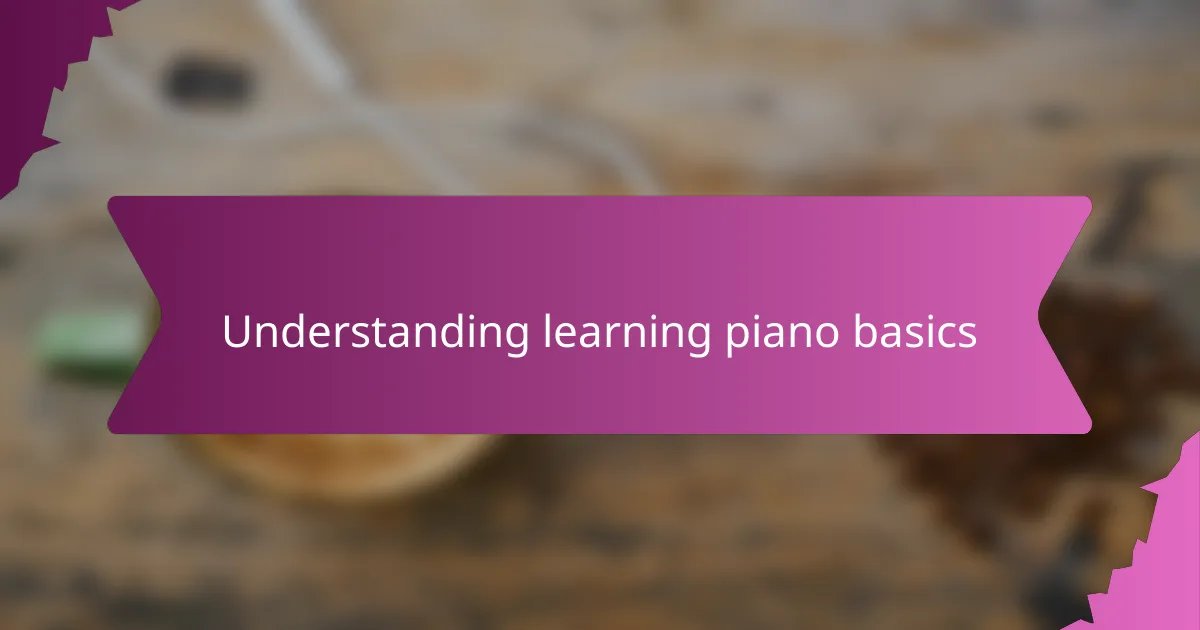
Understanding learning piano basics
Understanding the basics of piano learning is crucial before diving into Chopin’s intricate pieces. When I first sat at the keyboard, I realized how essential it is to grasp fundamental techniques like finger positioning and hand coordination. Without these building blocks, even the most beautiful compositions can feel overwhelming.
Have you ever struggled with coordinating both hands on the piano? I certainly did. Mastering simple scales and exercises helped me build the muscle memory I needed, turning frustration into small victories. These basics became my foundation, giving me the confidence to approach more complex works later.
Sometimes, I think the joy of learning piano comes from these early moments of discovery. It’s not just about playing notes; it’s about connecting with the instrument and understanding how it responds to your touch. This connection is what transforms basic skills into expressive playing.
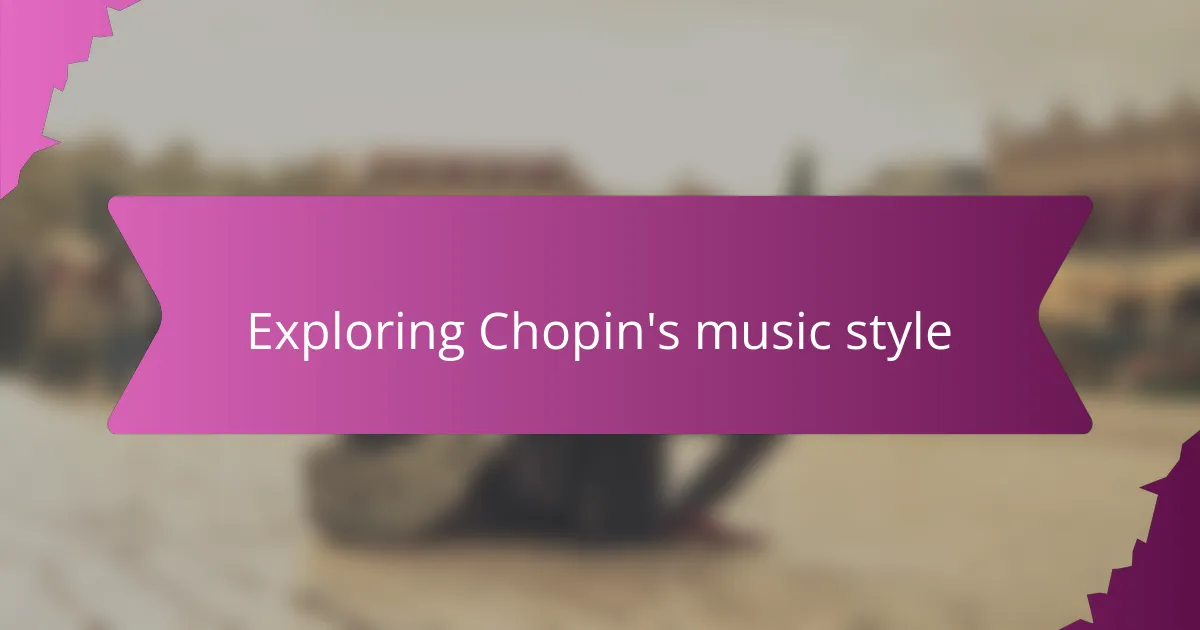
Exploring Chopin’s music style
Chopin’s music style is a world of its own, filled with emotion and nuanced expression. When I first tackled his nocturnes, I was struck by how every note seemed to sing, demanding more than just technical skill—it called for feeling and subtlety. Have you ever noticed how his melodies glide effortlessly yet hold a weight of longing? That’s the magic of his style.
What really fascinates me is Chopin’s use of rubato, a sort of flexible timing that breathes life into the music. At first, it felt almost like breaking the rules, but soon I realized it was about personal interpretation. This freedom made me feel like the piano wasn’t just an instrument but a partner in storytelling.
His intricate ornamentation and delicate phrasing taught me patience and precision. Playing Chopin isn’t about speed; it’s about crafting a mood, painting with sound. Each piece became a lesson in expressing what words can’t capture, turning technique into poetry.
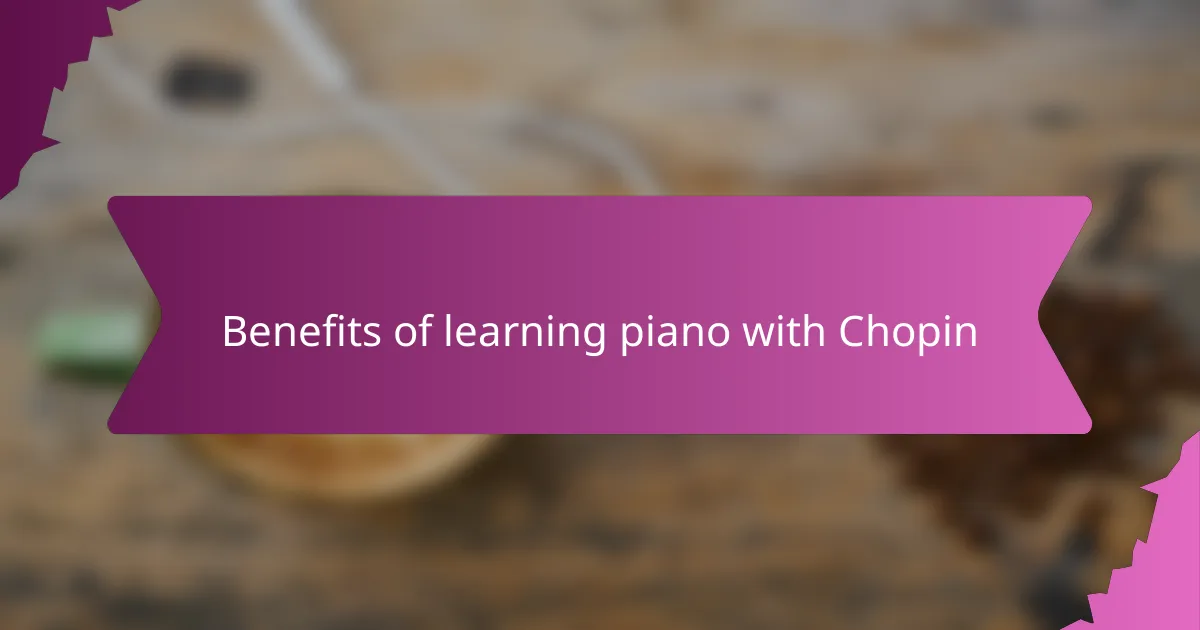
Benefits of learning piano with Chopin
Learning piano through Chopin’s works opened my eyes to the depth and emotion that music can convey. Have you ever felt that a piece of music is not just heard but deeply felt? Playing Chopin made me realize that mastering his pieces isn’t just about hitting the right keys—it’s about immersing yourself in the emotional journey behind every note.
One of the greatest benefits I found was how Chopin’s music challenged and refined my technique without making it feel like a chore. His flowing legato passages and delicate dynamics pushed me to develop a sensitive touch and control, skills that have stayed with me long after learning his compositions. It’s like his music gently demanded precision while giving me room to express myself.
I also discovered that tackling Chopin’s pieces gave me real confidence as a pianist. When I finally played a nocturne smoothly, it was a moment of pure joy and accomplishment. Doesn’t achieving something that once seemed impossible make the entire learning experience worthwhile? For me, Chopin’s music transformed my approach to piano into a more expressive and heartfelt art.
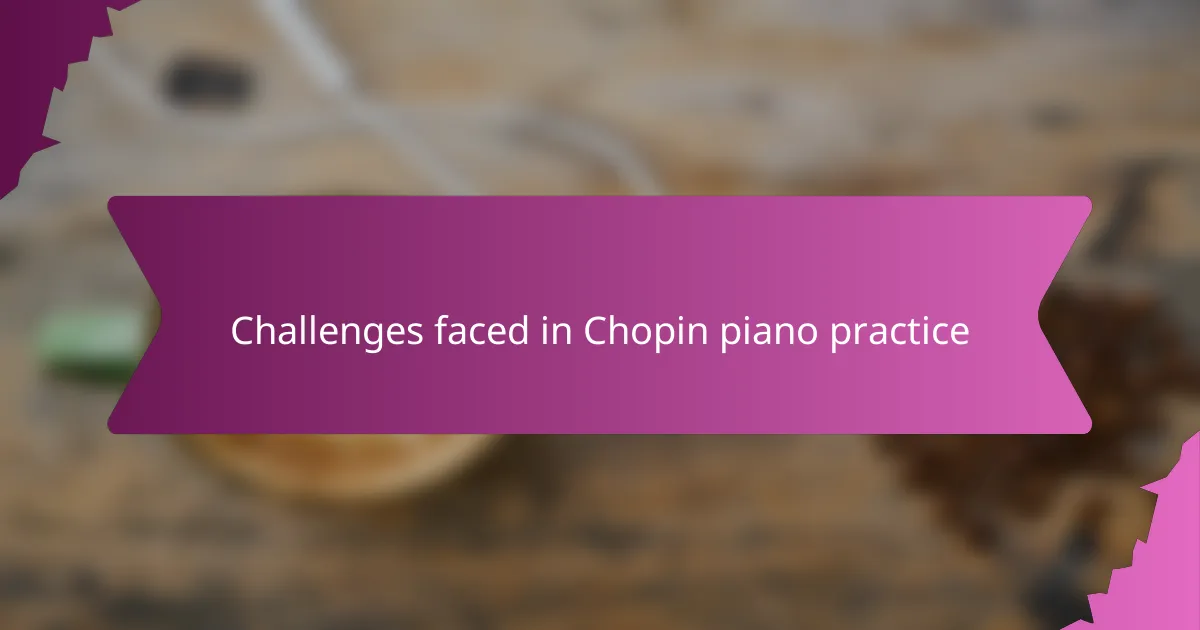
Challenges faced in Chopin piano practice
Practicing Chopin’s music wasn’t without its hurdles. I remember struggling particularly with his rapid arpeggios and the delicate balance between speed and clarity—sometimes my fingers wanted to sprint ahead, but the music called for grace and control. Have you ever felt that tension between technical demands and expressive freedom? That was a constant challenge for me.
Another tricky part was mastering Chopin’s frequent use of rubato—the subtle stretching and squeezing of time. At first, I found it confusing, unsure how far I could bend the tempo without losing the piece’s rhythm. It felt like walking a tightrope between strict timing and emotional expression, a skill that took patience and repeated listening to internalize.
Then there’s the emotional weight of his compositions. Playing Chopin isn’t just about fingers hitting keys; it’s about conveying deep feelings, sometimes sorrow or longing, which can be mentally exhausting. Have you ever felt emotionally drained after playing a piece that demands so much from your heart as well as your hands? For me, those moments were reminders that learning Chopin involves more than technique—it requires vulnerability.
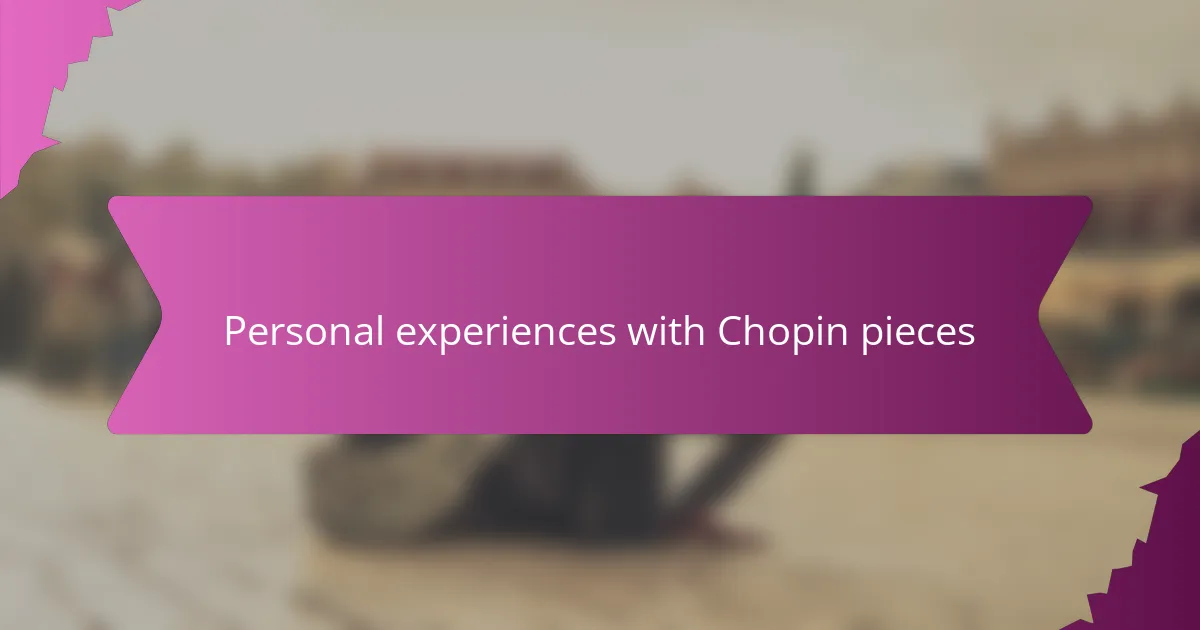
Personal experiences with Chopin pieces
When I first attempted Chopin’s Ballade No.1, I was overwhelmed by its dramatic shifts and swirling emotions. Have you ever played something that felt like a story unfolding beneath your fingers? For me, each phrase was a new challenge to express, and it took many slow, deliberate repetitions before the music finally felt alive.
I also recall the quiet intimacy of practicing his Preludes late at night. There’s something humbling about feeling so vulnerable while pouring your emotions into those short, delicate pieces. Do you ever find that certain music sessions stay with you long after you’ve stopped playing? Those moments of solitude and reflection with Chopin’s music became a kind of personal meditation for me.
On a technical level, mastering Chopin’s Etudes was both exhausting and exhilarating. I remember struggling endlessly with the rapid finger work, yet every small breakthrough felt like unlocking a new world of possibilities. Have you experienced that thrill of finally nailing a passage that seemed impossible? For me, it was proof that persistence and patience with Chopin’s work can truly transform your playing.
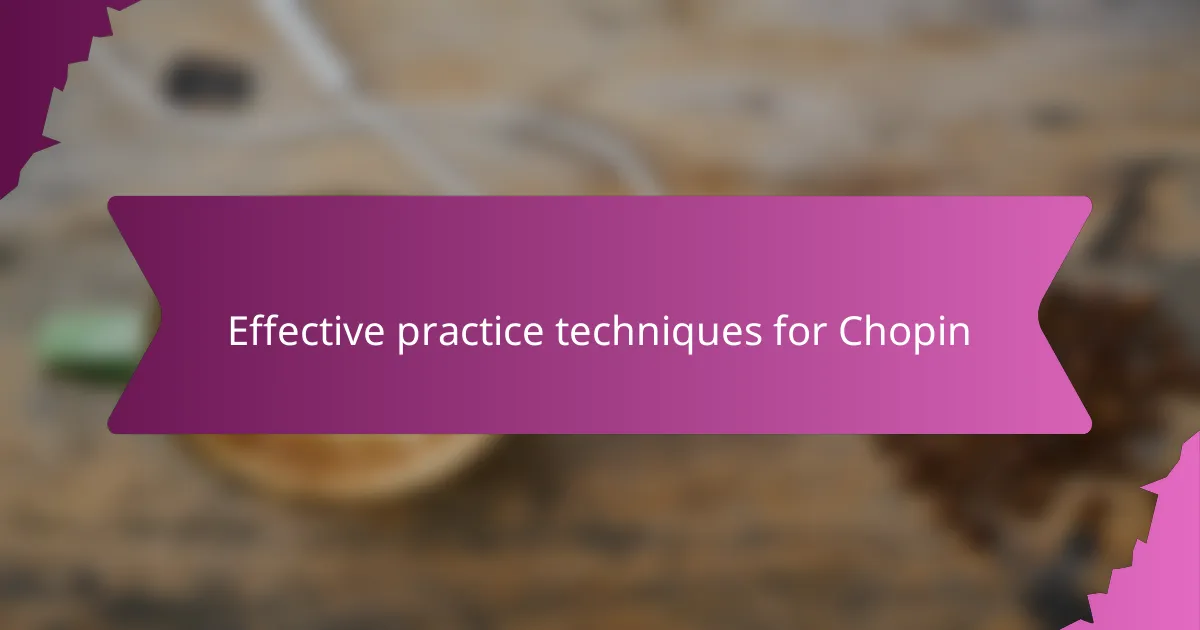
Effective practice techniques for Chopin
Practicing Chopin effectively means embracing slow, focused repetition rather than rushing through his intricate passages. I found that playing each phrase at a reduced tempo helped me truly hear every nuance and avoid mechanical mistakes. Have you ever noticed how slowing down can actually reveal more emotion and detail than playing fast ever could?
One technique that changed my approach was isolating tricky sections and looping them repeatedly until my fingers and mind synced perfectly. It felt tedious at times, but those patterns eventually became muscle memory, freeing me to focus on expression. Don’t underestimate the power of patience; Chopin’s music rewards those willing to dig deep into its complexities.
Another key for me was balancing precision with feeling, especially when working on rubato. Trying to control timing but also letting the music breathe seemed contradictory at first. How do you practice flexibility in timing without losing structure? For me, recording my sessions and listening back became a revealing tool—it helped me find that delicate dance between technical exactness and heartfelt interpretation.
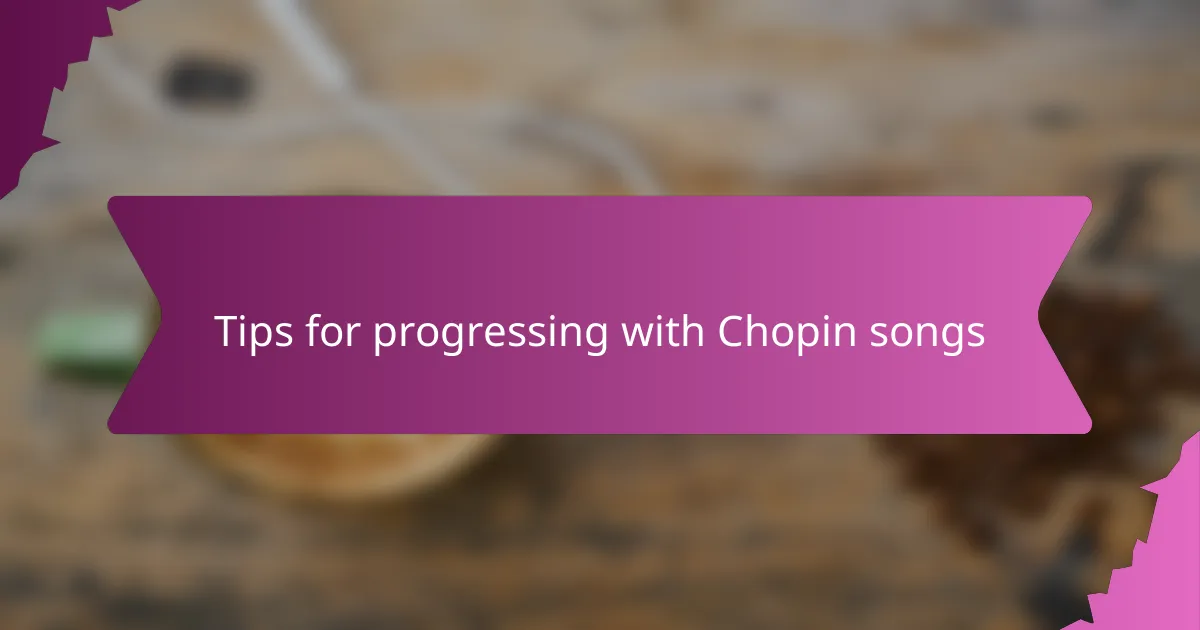
Tips for progressing with Chopin songs
Progressing with Chopin’s songs taught me that patience is everything. Have you ever felt stuck on a phrase that just won’t flow? Slowing down and breaking it into tiny pieces made all the difference—each small victory built the confidence I needed to move forward without frustration.
I also learned the importance of listening deeply, not just playing notes. Sometimes, I recorded myself and noticed subtle imbalances or tensions I hadn’t felt while playing. This helped me adjust my touch and phrasing, turning technical execution into genuine musical expression.
Lastly, embracing the emotional complexity of Chopin’s music was key. When a passage felt overwhelming, I reminded myself that it’s okay to feel vulnerable through the music. How else can we truly convey the longing or joy embedded in his notes? Accepting that emotional challenge made every practice session richer and more rewarding.